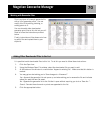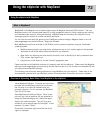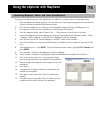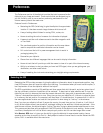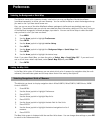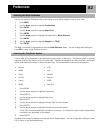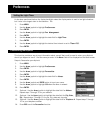
77
The Preferences portion of the eXplorist provides the tools to personalize the
eXplorist to your usage and needs. There are tools that are designed to give
you full flexibility over its use as well as performing maintanence on the
internal memory should the need arise.
Features found in Preferences:
• Restarting the GPS (Initializing) to give the eXplorist its approximate
location if it has been moved a large distance while turned off.
• A way of setting default folders for saving POI’s, routes, etc.
• Access to setting the units of measure for information displayed.
• A means to set the north reference used to be either magnetic north
or True North.
• The coordinate system for position information and the map datum
used to compute the coordinate information can be chosen.
• Full control over the built-in power-management tools to assist in
prolonging battery life.
• Personalize your eXplorist.
• Choose from ten different languages that can be used to display information.
• Access to tools that will provide you with the means to clear all or part of the internal memory.
• Ability to set alarms to alert you when you have lost GPS signal, when you are getting near your
destination, and other useful alerts.
• A way of resetting the clock and customizing your daylight savings requirements.
Restarting the GPS provides a means of giving the eXplorist information about its approximate position, long
time GPS receiver users will know this option as initializing. To understand when you would use this option, a
breif explanation of how the eXplorist works will be helpful.
The GPS constellation consists of 24 satellites and three spares that orbit the earth, and at any given time of
the day a different collection of satellites will be overhead. To keep track of what satellites are in view, the
eXplorist has a built-in almanac that uses the present date and time, along with its approximate position, to
“look-up” what satellites should be in view. Every time you turn your eXplorist off, it records in a special place
in its memory, the last position fix computed, and then when it is turned back on, it assumes that it is still in
the same approximate location and uses this last position fix when doing its “look-up” in the almanac.
Now if you turn your eXplorist off and fly across the country, the next time you turn it back on, it will think it
is still at the location where it was turned off, and begin looking for the satellites it thinks are overhead. If the
satellites are not there, the eXplorist begins “polling” the skies, trying to determine what satellites are in view.
This process can take time and can appear as if the GPS portion of the eXplorist is not working. Under normal
conditions, the eXplorist will still be able to compute your position but this can take longer then normal.
What Restart GPS does is it gives you the ability to give the eXplorist its approximate location, hence
speeding up the time to acquire its first fix. Many eXplorist users will never need to use the Restart the GPS
option, but it is available should the need arise.
Restarting the GPS
Preferences




